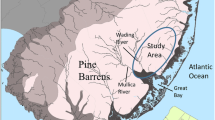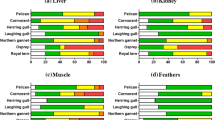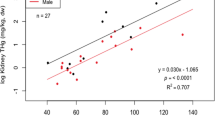Abstract
The giant garter snake (GGS; Thamnophis gigas) is a federally listed threatened species endemic to wetlands of the Central Valley of California. Habitat destruction has been the main factor in the decline of GGS populations, but the effects of contaminants on this species are unknown. To contribute to the recovery of these snakes, the U.S. Geological Survey (USGS) began studies of the life history and habitat use of GGSs in 1995. During a series of investigations conducted from 1995 to the present, specimens of dead GGSs were opportunistically collected from the Colusa National Wildlife Refuge (CNWR), the Natomas Basin, and other sites in northern California. Whole snakes were stored frozen for potential future analysis. As funding became available, we analyzed tissues of 23 GGSs to determine the concentrations of total mercury (Hg) and other trace elements in livers and concentrations of Hg in brains and tail clips. Mercury concentrations (μg/g, wet weight) ranged from 0.08 to 1.64 in livers, 0.01 to 0.18 in brains, and 0.02 to 0.32 in tail clips. In livers, geometric mean concentrations (μg/g, dry weight) of arsenic (25.7) and chromium (1.02) were higher than most values from studies of other snakes. Mercury concentrations in tail clips were positively correlated with concentrations in livers and brains, with the most significant correlations occurring at the Natomas Basin and when Natomas and CNWR were combined. Results indicate the value of using tail clips as a nonlethal bioindicator of contaminant concentrations.

Similar content being viewed by others
References
Bazar MA (2002) Effects of dietary methylmercury in juvenile corn snakes. MS thesis. Towson University, Towson, MD
Brode J (1988) Natural history of the giant garter snake (Thamnophis couchi gigas). In: DeListe HF, Brown PR, Kaufman B, McGurty BM (eds) Proceedings of the Conference on California Herpetology, Southwestern Herpetologists Society. Special Publication No. 4, pp 25–28
Burger J, Gochfeld M, Rooney AA, Orlando EF, Woodward AR, Guillette LJ Jr (2000) Metals and metalloids in tissues of American alligators in three Florida lakes. Arch Environ Contam Toxicol 38:501–508. doi:10.1007/s002449910066
Burger J, Campbell KR, Campbell TS, Shukla T, Jeitner C, Gochfeld M (2005) Use of skin and blood as nonlethal indicators of heavy metal contamination in northern water snakes (Nerodia sipedon). Arch Environ Contam Toxicol 49:232–238. doi:10.1007/s00244-004-0098-9
Burger J, Murray S, Gaines KF, Novak JM, Punshon T, Dixon C, Gochfeld M (2006) Element levels in snakes in South Carolina: differences between a control site and exposed site on the Savannah River site. Environ Monitor Assess 112:35–52. doi:10.1007/s10661-006-0695-3
Burger J, Campbell KR, Murray S, Campbell TS, Gaines KF, Jeitner C, Shukla T, Burke S, Gochfeld M (2007) Metal levels in blood, muscle and liver of water snakes (Nerodia spp.) from New Jersey, Tennessee and South Carolina. Sci Total Environ 373:556–563. doi:10.1016/j.scitotenv.2006.06.018
Campbell KR, Campbell TS (2001) The accumulation and effects of environmental contaminants on snakes: a review. Environ Monit Assess 70:253–301. doi:10.1023/A:1010731409732
Campbell KR, Campbell TS (2002) A logical starting point for developing priorities for lizard and snake Ecotoxicology: a review of available data. Environ Toxicol Chem 21:894–898. doi: 10.1897/1551-5028(2002)021<0894:ALSPFD>2.0.CO;2
Campbell KR, Campbell TS, Burger J (2005) Heavy metal concentrations in northern water snakes (Nerodia sipedon) from East Fork Poplar Creek and the Little River, east Tennessee, USA. Arch Environ Contam Toxicol 49:239–248. doi:10.1007/s00244-004-0200-3
Domagalski JL (2001) Mercury and methylmercury in water and sediment of the Sacramento River Basin, California. Appl Geochem 16:1677–1691. doi:10.1016/S0883-2927(01)00068-3
Gremillion PT, Cizdziel JV, Cody NR (2005) Caudal fin mercury as a non-lethal predictor of fish-muscle mercury. Environ Chem 2:96–99. doi:10.1071/EN05018
Hopkins WA (2006) Use of tissue residues in reptile ecotoxicology: a call for integration and experimentalism. In: Gardner SC, Oberdörster (eds) Toxicology of reptiles. CRC Press, Boca Raton, FL, pp 35–62
Hopkins WA, Rowe CL, Congdon JD (1999) Elevated trace element concentrations and standard metabolic rate in banded water snakes (Nerodia fasciata) exposed to coal combustion wastes. Environ Toxicol Chem 18:1258–1263. doi: 10.1897/1551-5028(1999)018<1258:ETECAS>2.3.CO;2
Hopkins WA, Roe JH, Snodgrass JW, Jackson BP, Kling DE, Rowe CL, Congdon JD (2001) Nondestructive indices of trace element exposure in squamate reptiles. Environ Pollut 115:1–7. doi:10.1016/S0269-7491(01)00098-7
Hopkins WA, Roe JH, Snodgrass JW, Staub BP, Jackson BP, Congdon JD (2002) Effects of chronic dietary exposure to trace elements on banded water snakes (Nerodia fasciata). Environ Toxicol Chem 21:906–913. doi: 10.1897/1551-5028(2002)021<0906:EOCDET>2.0.CO;2
Hopkins WA, Snodgrass JW, Baionno JA, Roe JH, Staub BP, Jackson BP (2005) Functional relationships among selenium concentrations in the diet, target tissues, and nondestructive tissue samples of two species of snakes. Environ Toxicol Chem 24:344–351. doi:10.1897/03-601.1
Jayne BC, Bennett AF (1989) The effect of tail morphology on locomotor performance of snakes: a comparison of experimental and correlative methods. J Exp Zool 252:126–133. doi:10.1002/jez.1402520204
Ohlendorf HM, Hothem RL, Aldrich TW (1988) Bioaccumulation of selenium by snakes and frogs in the San Joaquin Valley, California. Copeia 1988:704–710. doi:10.2307/1445391
Rainwater TR, Reynolds KD, Cañas JE, Cobb GP, Anderson TA, McMurry ST, Smith PN (2005) Organochlorine pesticides and mercury in cottonmouths (Agkistrodon piscivorus) from northeastern Texas, USA. Environ Toxicol Chem 24:665–673. doi:10.1897/04-223R.1
Rytuba JJ (2000) Mercury mine drainage and processes that control its environmental impact. Sci Total Environ 260:57–71. doi:10.1016/S0048-9697(00)00541-6
Rytuba JJ (2003) Mercury from mineral deposits and potential environmental impact. Environ Geol 43:326–338
Shine R, Olsson MM, Moore IT, LeMaster MP, Mason RT (1999) Why do male snakes have longer tails than females? Proc R Soc Lond B 266:2147–2151. doi:10.1098/rspb.1999.0901
Sparling DW, Bishop CA, Linder G (2000) The current status of amphibian and reptile ecotoxicological research. In: Sparling DW, Linder G, Bishop CA (eds) Ecotoxicology of amphibians and reptiles. Society of Environmental Toxicology and Chemistry, Pensacola, FL, pp 1–13
U.S. Fish Wildlife Service (1993) Endangered and threatened wildlife and plants; determination of threatened status for the giant garter snake. Fed Register 58:54053–54066
U.S. Fish Wildlife Service (1999) Draft recovery plan for the giant garter snake (Thamnophis gigas). U.S. Fish and Wildlife Service, Portland, OR
Willis L, Threlkeld ST, Carpenter CC (1982) Tail loss patterns in Thamnophis (Reptilia: Colubridae) and the probable fate of injured individuals. Copeia 1982:98–101. doi:10.2307/1444273
Wylie GD, Casazza ML (2000) Investigations of giant garter snakes in the Natomas Basin: 1998–1999—Project Summary. USGS-BRD, Western Ecological Research Center. Dixon Field Station, Dixon, CA
Wylie GD, Casazza ML, Daugherty J (1997) 1996 progress report for the giant garter snake study. USGS-BRD, Western Ecological Research Center. Dixon Field Station, Dixon, CA
Wylie GD, Casazza ML, Carpenter M (2003a) Diet of bullfrogs in relation to predation on giant garter snakes at Colusa National Wildlife Refuge. Calif Fish Game 89:139–145
Wylie GD, Casazza ML, Martin LL, Carpenter NM (2003b) Monitoring giant garter snakes at Colusa National Wildlife Refuge: 2003 progress report. USGS-BRD, Western Ecological Research Center. Dixon Field Station, Dixon, CA
Acknowledgments
This study was conducted in cooperation with the U.S. Fish and Wildlife Service Sacramento National Wildlife Refuge and the Sacramento Office of Ecological Services. Funding was provided by the U.S. Geological Survey and the U.S. Fish and Wildlife Service. Specimens were collected in accordance with our U.S. Fish and Wildlife Service Recovery Permit TE-020548-5. Numerous U.S. Geological Survey biological technicians and biologists assisted with field collections. Kate DeClercq assisted with snake dissection and prepared snakes for shipment to the contract laboratory, and Melissa Farinha prepared the figure. Tom Suchanek, Julie Yee, Melissa Farinha, and an anonymous reviewer provided many helpful comments on the manuscript. Any use of trade, product, or firm names in this publication is for descriptive purposes only and does not imply endorsement by the U.S. government.
Author information
Authors and Affiliations
Corresponding author
Rights and permissions
About this article
Cite this article
Wylie, G.D., Hothem, R.L., Bergen, D.R. et al. Metals and Trace Elements in Giant Garter Snakes (Thamnophis gigas) from the Sacramento Valley, California, USA. Arch Environ Contam Toxicol 56, 577–587 (2009). https://doi.org/10.1007/s00244-008-9265-8
Received:
Accepted:
Published:
Issue Date:
DOI: https://doi.org/10.1007/s00244-008-9265-8




